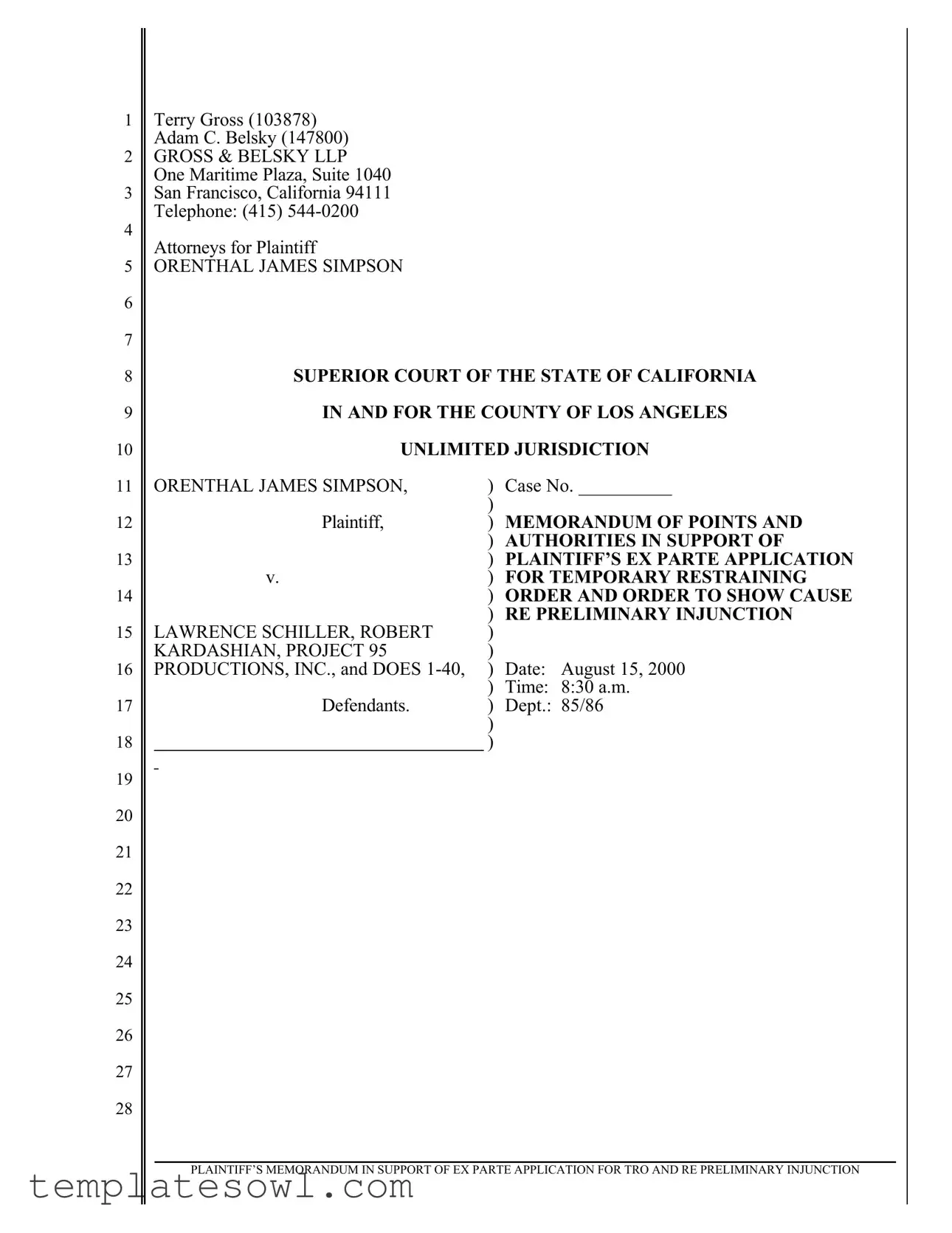1Terry Gross (103878) Adam C. Belsky (147800)
2GROSS & BELSKY LLP
One Maritime Plaza, Suite 1040
3San Francisco, California 94111
|
Telephone: (415) 544-0200 |
|
|
|
4 |
|
|
|
|
|
|
|
Attorneys for Plaintiff |
|
|
|
5 |
ORENTHAL JAMES SIMPSON |
|
|
|
6 |
|
|
|
|
|
|
7 |
|
|
|
|
|
|
8 |
|
|
SUPERIOR COURT OF THE STATE OF CALIFORNIA |
9 |
|
|
IN AND FOR THE COUNTY OF LOS ANGELES |
10 |
|
|
UNLIMITED JURISDICTION |
11 |
ORENTHAL JAMES SIMPSON, |
) Case No. __________ |
|
|
|
|
) |
|
|
12 |
|
|
Plaintiff, |
) MEMORANDUM OF POINTS AND |
|
|
|
|
) AUTHORITIES IN SUPPORT OF |
13 |
|
|
|
) PLAINTIFF’S EX PARTE APPLICATION |
|
|
|
v. |
) |
FOR TEMPORARY RESTRAINING |
14 |
|
|
|
) ORDER AND ORDER TO SHOW CAUSE |
|
|
|
|
) |
RE PRELIMINARY INJUNCTION |
15 |
LAWRENCE SCHILLER, ROBERT |
) |
|
|
|
KARDASHIAN, PROJECT 95 |
) |
|
|
16 |
PRODUCTIONS, INC., and DOES 1-40, |
) |
Date: |
August 15, 2000 |
|
|
|
|
) |
Time: |
8:30 a.m. |
17 |
|
|
Defendants. |
) |
Dept.: 85/86 |
|
|
|
|
) |
|
|
18 |
|
|
|
) |
|
|
19 |
|
|
|
|
|
|
|
|
|
|
|
|
20 |
|
|
|
|
|
|
21 |
|
|
|
|
|
|
22 |
|
|
|
|
|
|
23 |
|
|
|
|
|
|
24 |
|
|
|
|
|
|
25 |
|
|
|
|
|
|
26 |
|
|
|
|
|
|
27 |
|
|
|
|
|
|
28 |
|
|
|
|
|
|
PLAINTIFF’S MEMORANDUM IN SUPPORT OF EX PARTE APPLICATION FOR TRO AND RE PRELIMINARY INJUNCTION
STATEMENT OF FACTS
2It is a bedrock principle of American jurisprudence that clients may speak to their attorneys in
3complete confidence, and that the work of their attorneys shall similarly be protected from disclosure.
4This principle obviously applies equally for all criminal defendants, popular or unpopular, rich or poor,
5famous or obscure. There is no media exception to an attorney’s ethical duties of loyalty and
6confidentiality to his client. It is also a basic principle of American law to enforce agreements
7prohibiting the disclosure of confidential information. Here, however, the temptation of fame and
8fortune blinded one of O.J. Simpson’s attorneys, Robert Kardashian, and an author, Lawrence Schiller,
9who saw the opportunityofa bestseller beckoning. They conspired to insinuate Schiller into Simpson’s
10confidence and for Kardashian to make surreptitious tape recordings and notes about confidentialclient
11information, which he disclosed to Schiller. Both made fraudulent representations that they were co-
12authoring a book and that they would submit any manuscript to Simpson to ensure that it contained no
13privileged or confidential information. Both breached their fiduciary duties and confidentiality
14agreements, first by writing a book, and now for Schiller to direct and produce a television miniseries,
15just in production, based almost entirely on improperly obtained information purported to be attorney-
16client privileged communications or confidential defense team discussions.
17A TRO and preliminary injunction enjoining defendants from any further actions to participate
18in or transfer rights associated with the miniseries is essential to preserve Simpson’s rights, as the wide
19dissemination of information concerning confidential client conversations and discussions cannot be
20undone. There is no First Amendment prohibition against an injunction to prevent disclosure of
21information obtained in violation of confidentiality agreements or in breach of fiduciary duties. That
22Schiller previously published a book containing information in the miniseries is not a defense to an
23injunction, since the miniseries screenplay contains additional, undisclosed information. Also, courts
24can enjoin a wrongdoer from further and more widespread acts of disclosure.
25
26Kardashian was one of Simpson’s lawyers during Simpson’s criminal trial. Schiller, a friend of
27Kardashian, called Kardashian immediately upon learning of the murders, and began encouraging
28Kardashian to surreptitiously take notes and tape record events. Gross Dec. ¶¶ 9(c), 10(c), 14(d), 17(a)
1
PLAINTIFF’S MEMORANDUM IN SUPPORT OF EX PARTE APPLICATION FOR TRO AND RE PRELIMINARY INJUNCTION
1& Exs. E, F, J, M. Near the end of the trial, Schiller encouraged Kardashian to represent he was co-
2authoring an “as-told-to” book from Kardashian’s point of view, with Schiller to do the writing.
3Simpson Dec. ¶¶ 2-3.
4At the close of Simpson’s trial, Simpson reminded his attorneys that, due to their fiduciary
5obligations, they could not disclose privileged communications or confidential client information,
6without written authorization. Simpson Dec. ¶¶ 5, 19 & Exs. A, F; Dershowitz Dec. ¶¶ 2-4; Scheck
7Dec. ¶¶ 2-4; Neufeld Dec. ¶¶ 2, 3, 7; Chapman Dec. ¶¶ 2-3; Douglas Dec. ¶¶ 2-3; Blasier Dec. ¶¶ 2-3;
8Thompson Dec. ¶¶ 2-3; Bailey Dec. ¶¶ 2, 5; Taft Dec. ¶¶ 3,8.
9Kardashian and Schiller each spoke to Simpson, and stated that they wanted to co-author a
10book from Kardashian’s point of view. They each agreed that they would not include privileged and
11confidential client information in any manuscript unless Simpson gave approval, and would submit any
12manuscript to Simpson prior to publication for review and deletion of such material. Both sent letters
13to Simpson that confirmed they were collaborating on a book. Simpson Dec. ¶¶ 7, 9-10, 12-15, 17,
1428-29 & Exs. C-D; Taft Dec. ¶¶ 4-12 & Exs. B-C, E-F; Neufeld Dec. ¶ 8. Schiller admitted that he
15utilized Kardashian to gain access to defense team members. Gross Dec. ¶ 14(e) & Ex. J.
16Schiller insinuated himself into a position of trust and confidence with Simpson, by assisting the
17criminal defense team on a number of matters, such as obtaining clean audio copies of tape recordings
18of interviews with key witness Mark Fuhrman; assisting Simpson during the trial in writing a book, I
19Want to Tell You; convincing Simpson that Schiller should co-author Simpson’s first-person account
20of the trial; signing an agreement concerning this book that he would keep confidential all interviews
21arranged by Simpson, and giving Simpson the right to change or delete any material in the final
22manuscript; and after Simpson’s acquittal, assisting Simpson in producing a video about the case and
23assisted in raising funds. Simpson Dec. ¶¶ 8-9, 11 & Ex. B; Douglas Dec. ¶ 9. Schiller since admitted
24that he took these actions for exploitation, to manipulate and ingratiate himself with Simpson and the
25defense team and to gain access, “keeping his eye on the prize.” Gross Dec. ¶¶ 10(b), 11(b), 12, 17(b)-
26(d), 19 & Exs. F-H, M, O.
27In November 1995, Kardashian informed Simpson that his publisher, Random House, to
28approve Kardashian’s book deal, needed a letter from Simpson, and sent a draft letter that would have
2
PLAINTIFF’S MEMORANDUM IN SUPPORT OF EX PARTE APPLICATION FOR TRO AND RE PRELIMINARY INJUNCTION
1granted an explicit waiver by Simpson of his privilege as to any communications between Simpson and
2Kardashian. Simpson refused to sign, as he was not willing to waive his privileges. Kardashian
3negotiated with Simpson’s attorneys and finally obtained a letter that did not authorize any waiver that
4he said would be acceptable to his publisher. Thereafter, Kardashian made repeated representations
5that he was writing a book with Schiller and would submit any manuscript for review, and never, until
6the impending publication of the book, stated anything otherwise. Simpson Dec. ¶¶ 14-22, 28-29 &
7Exs. D-I; Taft Dec. ¶¶ 5-14 & Exs. B-G; Neufeld Dec. ¶ 8; Douglas Dec. ¶ 4; Scheck Dec. ¶ 6.
8In late 1995 and early 1996, Schiller spoke to Simpson, stating that some lawyerson the defense
9team would not speak to him, and requesting that Simpson give these lawyers permission to speak to
10Schiller. Schiller explicitly represented and agreed that the interviews were for Kardashian’s book, that
11everything the other attorneys would say to him would be protected and not disclosed due to
12Kardashian’s responsibilities as Simpson’s lawyer, that no privileged or confidentialinformation would
13be published unless Simpson gave explicit approval, and that prior to dissemination he and Kardashian
14would submit any manuscript to Simpson for his review. In light of these representations, Simpson
15agreed to give members of his defense team permission to speak to Schiller, and thereafter complied
16with his obligations. Simpson never gave any attorney permission to disclose confidential or privileged
17information to Schiller. Simpson Dec. ¶¶ 23-27.
18Schiller admits that he interviewed eight attorneys on Simpson’s defense team, other than
19Kardashian. Gross Dec. ¶ 13(c) & Ex. I. All eight attorneys state that Schiller made agreements with
20them, in exchange for their agreeing to be interviewed, that the interviews were for a book he was co-
21authoring with Kardashian, and that he would submit any manuscript to Simpson for review and
22removal of any privileged or confidential information. Kardashian made similar representations. If
23Kardashian had not been a co-author of the book and if Schiller and Kardashian had not made such
24representations, these attorneys would not have agreed to be interviewed. Dershowitz Dec. ¶¶ 5-9;
25Scheck Dec. ¶¶ 5-11; Chapman Dec. ¶¶ 4, 6; Douglas Dec. ¶¶ 4-10; Blasier Dec. ¶¶ 4-6; Thompson
26Dec. ¶¶ 4-8; Bailey Dec. ¶¶ 6-11; Craig Dec. ¶¶ 3-4.
27In August 1996, when Simpson’s attorney learned that Kardashian’s book was nearing
28completion, he contacted both Kardashian and Schiller to obtain a copy. Both Schiller and Kardashian
3
PLAINTIFF’S MEMORANDUM IN SUPPORT OF EX PARTE APPLICATION FOR TRO AND RE PRELIMINARY INJUNCTION

1
2
3
4
5
6
7
8
9
10
11
12
13
14
15
16
17
18
19
20
21
22
23
24
25
26
27
28
confirmed to him and Simpson that the manuscript would be submitted to Simpson, and Schiller made arrangements with Simpson’s lawyers to review the manuscript. Neufeld Dec. ¶¶ 9-18 & Exs. B-C; Simpson Dec. ¶¶ 30-31. Shortly thereafter, Schiller stated for the first time that Random House was deciding whether to list Kardashian as an author, and subsequently that he was the sole author of the book. Simpson’s attorney was then informed that Random House refused to allow Schiller to submit the manuscript for review. Simpson Dec. ¶¶ 32-33; Neufeld Dec. ¶¶ 11, 12, 19. Simpson’s attorney sent a cease and desist letter to RandomHouse and Schiller’s attorney, informing them that publication of the book would breach fiduciary duties and contracts and was based on fraudulent conduct and would subject them to liability. Neufeld Dec. ¶¶ 20-21 & Exs. D-E.1/
In October 1996, Schiller published a book entitled American Tragedy: The Uncensored Story of the Simpson Defense (the “Book”). Schiller is listed as an author; Kardashian is not. Neither Schiller nor Kardashian submitted a draft of the manuscript of the Book to Simpson for review prior to publication. Neufeld Dec. ¶¶ 22-23; Simpson Dec. ¶ 34; Gross Dec. ¶ 13(a) & Ex. I.
The Book contains a substantial amount of information that Schiller admits is privileged and confidential client information, available only to members of Simpson’s defense team. Gross Dec. ¶¶ 9(b), 10(a), 11(a), 13(b) & Exs. E-G, I. The book jacket describes the Book as: “the untold story . .
.written from deep within the Simpson defense . . . recounted in authentic, often startling detail in the words of Simpson’s confidants, lawyers, special investigators, and expert witnesses . . . in the uncensored words of Simpson’s closest confidants and attorneys.” Schiller concedes, both in the Book and in subsequent interviews, that Kardashian was the source of a large portion of the purported privileged and confidential client information contained in the Book. Neufeld Dec. ¶¶ 24-25 & Ex. G; Gross Dec. ¶¶ 9(e), 10(e), 11(c), 13(b), 14(a) & Exs. E-G, I-J, L. Schiller admitted to several of Simpson’s attorneys that Kardashian provided such information to him. Dershowitz Dec. ¶ 10; Scheck Dec. ¶ 10; Blasier Dec. ¶ 7. Kardashian received compensation for his participation in the Book and promoted it. Gross Dec. ¶¶ 9(d), 14(b), 20 & Exs. E, J, P-Q. Schiller concedes he was writing a book with Kardashian. Gross Dec. ¶¶ 9(a), 14(f) & Exs. E, J.
1/ |
Whenthe Book was published, Simpson was involved in a civil trial brought by members of the Goldman |
|
and Brown families, and due to the financial and time pressures from that trial, was unable to bring a lawsuit to seek an injunction preventing the publication of the Book. Simpson Dec. ¶ 36.
4
PLAINTIFF’S MEMORANDUM IN SUPPORT OF EX PARTE APPLICATION FOR TRO AND RE PRELIMINARY INJUNCTION
1The StateBar ofCalifornia determined that Kardashiancommitted professionalmisconduct and
2violated Bus. & Prof. Code § 6068(e), suspending him for two years, based upon a stipulation by
3Kardashian. Neufeld Dec. ¶ 26 & Ex. H.
4In mid-May 2000, Simpson learned for the first time that Schiller was in the process of making
5a miniseries concerning Simpson’s trial, based on the information that Schiller had obtained while
6writing a book with Kardashian, and that Schiller was producing and directing. Simpson diligently
7acted to retain counsel in this matter and to bring this lawsuit. Simpson Dec. ¶¶ 37, 39.
8The screenplay for the Miniseries contains a substantial amount of information that purports to
9be privileged and confidential client information, i.e., conversations involving only counsel and
10Simpson, conversations involving only defense team members, and comments by counsel on defense
11strategy (approximately 152 pages out of a total of 193 pages). In addition, the Miniseries includes a
12large amount of such information that was not published in the Book (approximately 47 pages out of
13a total of 193 pages). Gross Dec. ¶¶ 6-7 & Ex. D; Sealed Belsky Dec. Ex. A. Last month, Simpson’s
14counsel sent letters to Schiller demanding that he cease and desist from any involvement with the
15Miniseries and requesting a copy of the screenplay for pre-publication review by Simpson. Schiller’s
16counsel responded that Schiller would not do so. Gross Dec. ¶¶ 3-5 & Exs. A-C. The Book was
17published to a limited audience; in contrast, the Miniseries is to be broadcast nationally by CBS
18Television in November, and will be seen by millions of viewers. Gross Dec. ¶¶ 22-23 & Exs. S, T.
20I. A PRELIMINARY INJUNCTION SHOULD ISSUE
21In determining whether to issue a preliminaryinjunction, a court must weigh two “interrelated”
22factors: (1) the likelihood that the plaintiff will succeed on the merits at trial; and (2) the relative interim
23harm that the plaintiff will likely suffer if an injunction is not issued compared to the likely interim harm
24to defendant if an injunction is issued. Butt v. State, 4 Cal. 4th 668, 677-78 (1992). “[T]he greater the
25plaintiff’s showing on one, the less must be shown on the other to support an injunction.” Id. at 678.
26Here, injunctive relief enjoining the dissemination of the Miniseries is essential, because once
27disseminated it will be impossible to undo the disclosures. See Point III, infra.
28
5
PLAINTIFF’S MEMORANDUM IN SUPPORT OF EX PARTE APPLICATION FOR TRO AND RE PRELIMINARY INJUNCTION

1
2
3
4
5
6
7
8
9
10
11
12
13
14
15
16
17
18
19
20
21
22
23
24
25
26
27
28
II.SIMPSON HAS SHOWN A LIKELIHOOD OF SUCCESS ON THE MERITS.
A.The Miniseries Consists Predominantly of Presumptively Privileged and Confidential Attorney-Client Communications or Defense Team Discussions
It cannot be disputed that the screenplay for the Miniseries is predominantly comprised of scenes that are purported to be conversations between Simpson and his attorneys, discussions between and among attorneys representing Simpson, and Simpson’s attorneys commenting in present time on defense strategy; in fact, these scenes are found on approximately 152 pages out of a total 193 pages in the screenplay. All of these scenes thus involve privileged and confidential client information. See, e.g., Cal. Evid. Code §§ 952, 954; City & County of San Francisco v. Superior Court, 37 Cal. 2d 227, 236-37 (1951). Schiller admitted to members of the defense team that Kardashian was the source of privileged and confidential information, and admitted in interviews that Kardashian was his primary source. He trumpets in the Book and interviews that his sources are Simpson’s attorneys, proclaiming that the Book is based on the “uncensored words of Simpson’s . . . attorneys” and was “written from deep within the Simpson defense . . . in the words of . . . Simpson’s lawyers, special investigators and expert witnesses.” Statement of Facts at 4.2/ Since Simpson has not waived his right to the confidentiality, these discussions are presumptively privileged and confidential. Bus. & Prof. Code
§6068(e); Evid. Code § 917; De Los Santos v. Superior Court, 27 Cal. 3d 677, 682 (1980). This type of information would lose its privileged and confidential nature only if defendants had properly and lawfully obtained the information. However, as demonstrated below, Simpson is likely to succeed in establishing that defendants obtained this information improperly and unlawfully by breaching confidentiality agreements and fiduciary duties.
B.Simpson Is Likely to Succeed on the Merits of His Claim for Conspiracy to Breach Kardashian’s Fiduciary Duties.
The evidence submitted demonstrates that, from the beginning of Kardashian’s representation, Schiller and he conspired to breach fiduciaryduties. The fiduciaryattorney and client relationship is “of
2/ |
Schiller contends that the information in the Book and Miniseries is accurate and factual, Gross Dec. |
|
¶18 & Ex. N, including the information which is purported to be of privileged and confidential communications. Thus, plaintiff need not demonstrate, or even claim, that the information contained in the Miniseries disclosed by his attorney is true and accurate, since an attorney violates his duty of loyalty simply by commenting on information concerning the attorney-client relationship, even if such comments are not true. See Part II.B., infra. In fact, some purported confidential client information is inaccurate. Thompson Dec. ¶ 9.
6
PLAINTIFF’S MEMORANDUM IN SUPPORT OF EX PARTE APPLICATION FOR TRO AND RE PRELIMINARY INJUNCTION
1the very highest character.” Lee v. State Bar, 2 Cal.3d 927, 939 (1970). “One of the principal
2obligations which bind an attorney is that of fidelity, the maintaining inviolate the confidence reposed
3in him . . . and at every peril to himself to preserve the secrets of his client.” Flatt v. Superior Court,
49 Cal. 4th 275, 289 (1994). See also Barber v. Municipal Court, 24 Cal. 3d 742, 750-51 (1979) (the
5fundamental right to counsel “embodies the right to communicate in absolute privacy with one’s
6attorney”); In re Jordan, 7 Cal. 3d 930, 940-41 (1972) (“protection of confidences and secrets is not
7a rule of mere professional conduct, but instead involves public policies of paramount importance”);
8Alkow v. State Bar, 3 Cal. 3d 924, 936 (1971). As the Supreme Court recently reemphasized:
9Attorneys have a duty to maintain undivided loyaltyto their clients to avoid undermining public
confidence in the legal profession and the judicial process. The effective functioning of the
10fiduciary relationship between attorney and client depends on the client’s trust and confidence in counsel. The courts will protect clients’ legitimate expectations of loyalty to preserve this
11essential basis for trust and security in the attorney-client relationship.
12People ex rel. Dept. of Corp. v. SpeeDee Oil Change Sys., Inc., 20 Cal. 4th 1135, 1146-47 (1999).
13Under California law, an attorneyhas an express statutoryduty, broader than the attorney-client
14privilege, “[t]o maintain inviolate the confidence, and at every peril to himself or herself to preserve the
15secrets, of his or her client.” Bus. & Prof. Code § 6068(e); Goldstein v. Lees, 46 Cal. App. 3d 614, 621
16& n.5 (1975). “The attorney’s lips are forever sealed” as to information gained during the attorney-
17client relationship. Stockton Theatres, Inc. v. Palermo, 121 Cal.App.2d 616, 625 (1953).
18Here, there is substantial evidence that Kardashian breached his fiduciary duties to Simpson.
19The State Bar of California recently determined that Kardashian violated Bus. & Prof. Code § 6068(e).
20Kardashian is the primary source of the information in the Book and Miniseries concerning attorney-
21client conversations and defense team discussions. Kardashian induced other Simpson attorneys to
22provide information to Schiller by representing that he was the co-author of the book and that any
23manuscript would be submitted to Simpson’s attorney for review. Kardashian received compensation
24for his participation in the Book and promoted the Book. See Statement of Facts.
25Schiller and Project 95 are jointly liable for Kardashian’s breaches. A person who “intentionally
26causes or assists an agent to violate a duty to his principal is subject to liability to the principal.”
27Restatement (Second) of Agency § 312 (1958). Numerous California cases have applied this principle.
28Bancroft-Whitney Co. v. Glen, 64 Cal. 2d 327, 353 (1966) (parties who cooperated in another’s breach
7
PLAINTIFF’S MEMORANDUM IN SUPPORT OF EX PARTE APPLICATION FOR TRO AND RE PRELIMINARY INJUNCTION
1offiduciaryduties liable for their participation); Pierce v. Lyman, 1 Cal. App. 4th 1093, 1104-06 (1991);
2Certified Grocers of Calif., Ltd. v. San Gabriel Valley Bank, 150 Cal. App. 3d 281, 289 (1983);
3Morales v. Field, DeGoff, Huppert & MacGowan, 99 Cal. App. 3d 307, 314-15 (1979); St. James
4Armenian Church of Los Angeles v. Kurkjian, 47 Cal. App. 3d 547, 552 (1975); Gray v. Sutherland,
5124 Cal. App. 2d 280, 290 (1954); Restatement (Second) of Agency § 312, comment c (1958) (“A
6person who, with notice that an agent is thereby violating his dutyto his principal, receives confidential
7information from the agent, may be enjoined from disclosing it”).
8The evidence is equally clear that Schiller induced, participated in, and reaped the benefit of
9Kardashian’s breach offiduciaryduties. Schiller encouraged Kardashian from the start of Kardashian’s
10 |
representation to surreptitiously take notes and tape record events for use in a book, encouraged |
11 |
Kardashian to represent that he was writing a book with Schiller, induced Kardashian to disclose |
12 |
privileged and confidential client information to him, and represented to Simpson and Simpson’s |
13 |
attorneys that the interviews he was conducting were for a book with Kardashian and that due to |
14 |
Kardashian’s fiduciary duties no privileged or confidential could be contained in any publication. The |
15 |
Book, and the Miniseries, are based primarily on informationimproperly obtained fromKardashian. See |
16 |
Statement of Facts. |
17 |
|
C. |
Simpson Is Likely to Succeed on the Merits of His Claims for Breaches |
|
|
|
of Schiller’s Contracts With Him and With His Attorneys |
18 |
|
|
|
|
|
Schiller entered into an oral agreement with Simpson, by promising to submit any manuscript |
19 |
|
|
|
|
from his interviews of Simpson’s defense team members to Simpson for pre-publication review and |
20 |
|
|
|
|
removal of any privileged or confidential information, in return for Simpson providing access to |
21 |
|
|
|
|
members of the defense team. Schiller breached this agreement, by refusing to submit the manuscript |
22 |
|
|
|
|
of the Book or the manuscript for the Miniseries to Simpson for pre-publication review. See Statement |
23 |
|
|
|
|
of Facts at 3-5. Any claim by Schiller that no such contract exists is belied by the declaration testimony |
24 |
|
|
|
|
to the contrary of all eight prominent members of the bar who Schiller interviewed. |
25 |
|
|
|
|
|
Simpson is equally likely to prevail on claim as third party beneficiary for breach of Schiller’s |
26 |
|
|
|
|
contracts with members of defense team. See generally Civ. Code § 1559 (“[a] contract, made |
27 |
|
|
|
|
expressly for the benefit of a third person, may be enforced by him”); 1 Witkin, Summary of Calif. Law |
28 |
(Contracts) § 656, at 595 (9th ed. 1987). Schiller breached oral agreements with all eight of Simpson’s |
|
|
|
|
8 |
|
|
PLAINTIFF’S MEMORANDUM IN SUPPORT OF EX PARTE APPLICATION FOR TRO AND RE PRELIMINARY INJUNCTION |

1
2
3
4
5
6
7
8
9
10
11
12
13
14
15
16
17
18
19
20
21
22
23
24
25
26
27
28
lawyers he interviewed that he would submit any manuscript concerning the interviews to Simpson for prepublication review and removal of any privileged and confidential information. See Statement of Facts at 3. These agreements clearly were for the benefit of Simpson as a third party beneficiary.
D.Simpson Is Likely to Succeed on the Merits of His Claim for Fraud.
As discussed above, the evidence demonstrates that: Schiller and Kardashian made numerous fraudulent representations to Simpson and members of his defense team that they were co-authoring a book, that no privileged and confidential information would be contained in any manuscript without Simpson’s approval, and that any manuscript would be submitted to Simpson for review and deletion of privileged and confidential information; Simpson and members of his defense team relied on these representations and provided access and information to Schiller; these representations were false; and Schiller and Kardashian knew them to be false and made them to induce Simpson and his agents to rely on them. Thus, Simpson is likely to succeed on his claim against defendants for fraud.3/
E.Simpson Is Likely to Succeed on the Merits of
His Claim for Breach of Schiller’s Fiduciary Duties.
Schiller also owed a separate fiduciary duty directly to Simpson by reason of their special relationship, which he also breached. “One who voluntarily assumes a position of trust and confidence is a fiduciary, and he remains a fiduciary as long as trust and confidence are reposed in him.” Sime v. Malouf, 95 Cal. App. 2d 82, 98 (1949); see also Tri-Growth Centre City, Ltd. v. Silldorf, Burdman, Duignan & Eisenberg, 216 Cal. App. 3d 1139, 1150 (1989); Pryor v. Bistline, 215 Cal. App. 2d 437, 446 (1963). “The very existence of such a relation precludes the party in whom the trust and confidence is reposed fromparticipating in profit or advantage resulting fromthe dealings of the parties to the relation.” Twomey v. Mitchum, Jones & Templeton, Inc., 262 Cal. App. 2d 690, 708 (1968). The facts demonstrate that Schiller had insinuated himself into a position of trust and confidence with Simpson and should be held to the standard of fiduciary for his betrayal of that confidence. See Statement of Facts at 2-3.
3/ |
Simpson’s cause of action for fraud, with a three-year statute of limitations, CCP § 338(d), is not time- |
|
barred, since the fraudulent conspiracy continues until the present. An action for civil conspiracy only accrues when the last overt act in furtherance of the conspiracy occurs. Wyatt v. Union Mortgage Co., 24 Cal. 3d 773, 786-88 (1979). Defendants are currently taking actions to produceand direct the Miniseries based on information obtained through the above-described fraudulent scheme in order to gain further profits from their fraud, and continue in their refusal to submit the manuscript for the Miniseries to Simpson for review.
9
PLAINTIFF’S MEMORANDUM IN SUPPORT OF EX PARTE APPLICATION FOR TRO AND RE PRELIMINARY INJUNCTION










